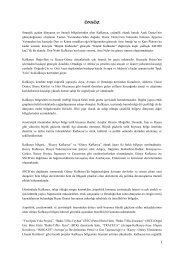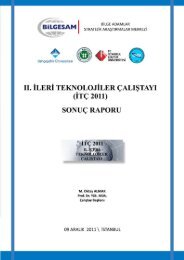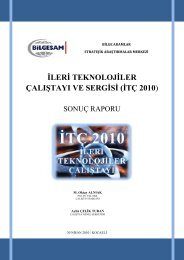- Page 1 and 2:
II. İLERİ TEKNOLOJİLER ÇALIŞTA
- Page 3 and 4:
BİLGİ NOTU VE TEŞEKKÜR Bahçeş
- Page 5 and 6:
İÇİNDEKİLER Bilgi Notu ve Teşe
- Page 7 and 8:
BACA GAZINDAKİ GİZLİ ISIYI KULLA
- Page 9 and 10:
RÜZGAR ENERJİSİ ÜRETİM SİSTEM
- Page 11 and 12:
CRITERION: ONLINE YAZMA DEĞERLEND
- Page 13 and 14:
ÖNSÖZ Bu çalışmalardan bir son
- Page 15 and 16:
AÇIŞ KONUŞMALARI KONGRE AÇILIŞ
- Page 17 and 18:
2006, 2007 yıllarında Ulusal ve U
- Page 19 and 20:
Faaliyeti kurumsal olarak organize
- Page 21 and 22:
İLERİ TEKNOLOJİLER STRATEJİSİ
- Page 23 and 24:
PLAZMA YAKIT PİLLERİ Prof. Dr. Be
- Page 25 and 26:
AÇIŞ KONUŞMALARI Prof. Dr. Şena
- Page 27 and 28:
öğrenim görmüş kişilerin gene
- Page 29:
SÖZLÜ BİLDİRİLER PANEL I SANAY
- Page 32 and 33:
32 ihracatı içinde imalat sanayi
- Page 34 and 35:
34 rine yönelik sektörel strateji
- Page 36 and 37:
36 Bu doğrultuda, Makina Sektörü
- Page 39 and 40:
KÜBİK BOR NİTRÜR (CBN) KAPLAMAL
- Page 41:
ATILIM ÜNİVERSİTESİNDE İLERİ
- Page 45 and 46:
İLERİ TEKNOLOJİ Mİ? YENİ TEKNO
- Page 47:
ATILIM ÜNİVERSİTESİ BÜNYESİND
- Page 50 and 51:
50 yapılan tüm çalışmalarımı
- Page 53 and 54:
TEKNOLOJİ ÇALIŞTAYI VE BAHÇEŞE
- Page 55:
Teknolojik gelişme ve ilerleme, ü
- Page 59 and 60:
FROM FUNDAMENTAL TO APPLIED ELECTRO
- Page 61 and 62:
chosen such that nucleation of new
- Page 63:
Testing and Accreditation of The Se
- Page 66 and 67:
66 each step. The analysis is carri
- Page 68 and 69:
68 According to the cumulative ener
- Page 71 and 72:
NİĞDE ÜNİVERSİTESİNDE KATI OK
- Page 73 and 74:
tabakası olmak üzere iki ayrı ta
- Page 75 and 76:
genleşme farkı hücrenin eğilmes
- Page 77 and 78:
soğutulması ve dinamik yükleme k
- Page 79 and 80:
3.1. PEM elektrolizörlerde Görün
- Page 81 and 82:
HİDROJEN SÜLFÜRDEN ELEKTROLİZ Y
- Page 83 and 84:
Çevre kirliliği açısından da s
- Page 85 and 86:
[11]. Saf H2S beslenen ve 135 kPa,
- Page 87 and 88:
5. Sonuç Araştırmalar elektroliz
- Page 89 and 90:
SÜREKLİ HİDROJEN ÇEVRİMİ AMAC
- Page 91 and 92:
Na2B4O7 CaB3O4(OH)3H2O Şekil 1. Hi
- Page 93 and 94:
3. NaBH4’ün Hidrolizi ve Hidroje
- Page 95 and 96:
NaBH4 + 6H2O → 4H2 + NaBO2.4H2O (
- Page 97 and 98:
negatif yüklüdür ve yüzeyi (H
- Page 99 and 100:
NaBO2 geri dönüşümünde karbon
- Page 101 and 102:
101 Çalışmalar bilyeli değirmen
- Page 103 and 104:
103 FTIR analizi NaBH4 varlığın
- Page 105 and 106:
105 10. Lyttle, D.A.; Jensen, E.H.;
- Page 107 and 108:
PANEL IV SANAYİ, EĞİTİM, BİLİ
- Page 109 and 110:
TEKNOGİRİŞİM SERMAYESİ DESTEĞ
- Page 111 and 112:
Başvuru Şekli Dokümanlar 111
- Page 113 and 114:
Ön Başvuru Dosyası � Başvuru
- Page 115 and 116:
EĞİTİM DURUMLARINA GÖRE DAĞILI
- Page 117 and 118:
ÜNİVERSİTE-SANAYİ İŞBİRLİĞ
- Page 119 and 120:
Üniversite-Sanayi İşbirliğinde
- Page 121 and 122:
121 nuda çalışma yapmak isteyen
- Page 123 and 124:
EĞİTİM ORTAMINA YENİLEŞİMCİ
- Page 125 and 126:
125 150 yıl önce kullanılmaya ba
- Page 127 and 128:
127 cihazlar olmaktaydı. Tüm bu e
- Page 129 and 130:
129 eğitime özel üretilmiş dona
- Page 131 and 132:
131 üzerinden internete ulaşarak
- Page 133 and 134:
133 Ülkemizde buluşunun yapılmas
- Page 135 and 136:
ENERJİ SEKTÖRÜNÜN GÖRÜNÜMÜ
- Page 137 and 138:
Dünya: Yenilenebilir ve Yatırıml
- Page 139 and 140:
Türkiye: Elektrik Santralleri ve
- Page 141 and 142:
2011 Yılında İşletmeye Açılan
- Page 143 and 144:
PANEL V NÜKLEER ENERJİDE İLERİ
- Page 145 and 146:
Özet EYLEMSİZLİKLE TUTUKLAMA FÜ
- Page 147 and 148:
Protiyum Döteryum Trityum Proton E
- Page 149 and 150:
149 Füzyon sisteminin (5) ile veri
- Page 151 and 152:
151 Manyetik tutuklamada çok güç
- Page 153 and 154:
ulunur. Son denklemde cs≈10 6 m/s
- Page 155 and 156:
155 ışınları yayınlar. Bu x ı
- Page 157 and 158:
BACA GAZINDAKİ GİZLİ ISIYI KULLA
- Page 159 and 160:
159 Türkiye’de yılda 750.000 ko
- Page 161 and 162:
161 Şekilde de görüldüğü üze
- Page 163 and 164:
HİDROJEN ENERJİSİ HAKKINDA DÜŞ
- Page 165 and 166:
165 Hidrojen enerjisi bu kriterleri
- Page 167 and 168:
Söz Konusu Kongrelerin Katılımc
- Page 169 and 170:
Sanayinin ve Enerjinin Geleceğinde
- Page 171 and 172:
YENİ NESİL NÜKLEER REAKTÖRLER V
- Page 173 and 174:
YAKIT PİLLERİ TEKNOLOJİLERİ 173
- Page 175 and 176:
Özet KATI OKSİT YAKIT PİLLERİND
- Page 177 and 178:
2. Deneysel Düzenek 177 Bütün s
- Page 179 and 180:
Tablo 1. Deneyde kullanılan malzem
- Page 181 and 182:
4. Sonuçlar ve Tartışma 181 Sonu
- Page 183 and 184:
Özet KATI OKSİT YAKIT PİLLERİ R
- Page 185 and 186:
185 olmadığı fakat polarizasyon
- Page 187 and 188:
Enerji Korunumu Enerji korunum denk
- Page 189 and 190:
Anot kanalı giriş basıncı (Pa)
- Page 191 and 192:
191 Hasar miktarının pil performa
- Page 193 and 194:
193 [17] Gunji A., Wen C., Otomo J.
- Page 195 and 196:
KATOT ÜRETİM PARAMETRELERİN KATI
- Page 197 and 198:
197 yüzey alanı ve porozitesine b
- Page 199 and 200:
199 Bütün örneklerde iki ark gö
- Page 201 and 202:
3.1.2. KİT Kalınlığının Etkis
- Page 203 and 204:
3.2.2. KAT Gözenekliliğinin Perfo
- Page 205 and 206:
[9] Gruzdev, A. I., Sov. Electroche
- Page 207 and 208:
PEM (Proton Exchange Membrane) ELEK
- Page 209 and 210:
209 hidrojen iyonları katoda geçm
- Page 211 and 212:
211 Nordlund ve arkadaşları [12]
- Page 213 and 214:
213 Ancak sıkıştırma plakası o
- Page 215 and 216:
215 ZnS sintilatör, detektör olar
- Page 217 and 218:
3.2.3. 25 cm 2 Köşeli Dizayn 217
- Page 219 and 220:
3.4. Deneysel Sonuçlar 219 Deneyle
- Page 221 and 222:
221 Şekil 9. Alınan nötron datal
- Page 223 and 224:
223 [3] Selamet O F, Becerikli F, A
- Page 225 and 226:
225 YAKIT PİLİ TEKNOLOJİSİ, TÜ
- Page 227 and 228:
2.2. PEMYP Konusunda Gerçekleştir
- Page 229 and 230:
2.2.4. Polimer Elektrolit Membranl
- Page 231 and 232:
2.3.2. Sabit Uygulamalar İçin Do
- Page 233 and 234:
Şekil 9. SBH Yakıt Pilli Araç 23
- Page 235 and 236:
3. Sonuç 235 Yakıt pilleri üreti
- Page 237 and 238:
KATI OKSİT YAKIT PİLLERİNDE (KOY
- Page 239 and 240:
239 KOYP’nin yüksek sıcaklıkta
- Page 241 and 242:
241 Şekil 2’de görüldüğü gi
- Page 243 and 244:
243 krom uçuculuğu, oluşan oksit
- Page 245 and 246:
Özet KATI OKSİT YAKIT PİLLERİ
- Page 247 and 248:
Test düzeneği şu şekilde hazır
- Page 249 and 250:
249 lar kullanılarak testler gerç
- Page 251 and 252:
Kaynakça 251 [1] M. Mori, Y. Liu,
- Page 253 and 254:
Özet KATI OKSİT YAKIT PİLLERİ
- Page 255 and 256:
255 silikat, borat ve boronsilikatl
- Page 257 and 258:
geçiş sıcaklığı(Tg), oluşan
- Page 259 and 260:
259 sözkonusu olamamaktadır. Yap
- Page 261 and 262:
Özet KATI OKSİT YAKIT HÜCRESİND
- Page 263 and 264:
263 olarak ortaya koyabilen bir mat
- Page 265 and 266:
Anot gaz kanalı Katot gaz kanalı
- Page 267 and 268:
Eşitlik (11)’de, viskoziteyi ve
- Page 269 and 270:
269 Anot (17) Katot (18) 3.2. Sın
- Page 271 and 272:
271 Üretilen tek hücreli KOYP ça
- Page 273 and 274:
Şekil 9. (Fırın Sıcaklığı: 8
- Page 275 and 276:
5. Sonuçlar Şekil 13. Performans
- Page 277 and 278:
ALTERNATİF ENERJİLER VE MAKİNE T
- Page 279 and 280:
OPTİK TEKNOLOJİSİNİN ÖLÇÜM T
- Page 281 and 282:
(a) (b) Şekil 1. Şebekeye enerji
- Page 283 and 284:
Odaklı Cisimden Yansımalı Tip: C
- Page 285 and 286:
ÜRETİMDE KALİTE ARTIŞINA BAĞLI
- Page 287 and 288:
Sonuç � Eksen hızları, ivmelen
- Page 289 and 290:
289 bir uygulamanın Internet üzer
- Page 291 and 292:
TAKIM TEZGAHLARI SEKTÖRÜNÜN GELE
- Page 293 and 294:
Sanayileşmek gelişmiş ülke olma
- Page 295 and 296:
295 kullanımının özendirilmesi,
- Page 297 and 298:
PEYNİR ALTI SUYUNDAN TEK KADEMELİ
- Page 299 and 300:
299 Bu çalışmada süt ve süt ü
- Page 301 and 302:
Tablo 1. Tek kademeli sistemde %5 k
- Page 303 and 304:
Biyogaz Üretimi (lt/gün) Gaz Kons
- Page 305 and 306:
305 Tek kademeli sistemde; 80 g ine
- Page 307 and 308:
ULAŞTIRMA SEKTÖRÜNDE ALTERNATİF
- Page 309 and 310:
309 Elektrikli araçlarda ortak nok
- Page 311 and 312:
Sekil 5. Yakıt pilli araç örnekl
- Page 313 and 314:
313 Yenilenebilir enerjinin, Türki
- Page 315 and 316:
Özet ENERJİ’DE GELİŞMELER - F
- Page 317 and 318:
� Biyoenerji - Biyoyakıt, � Ta
- Page 319 and 320:
319 � Enerji Verimli Evler ve Bin
- Page 321 and 322:
Özet YENİLENEBİLİR ENERJİ TEKN
- Page 323 and 324:
323 kullanılabilir olması, kullan
- Page 325 and 326:
325 Şekil 1. de dünyanın rüzgar
- Page 327 and 328:
3.4. Jeotermal Enerji 327 Jeotermal
- Page 329 and 330:
329 elde edilmesi esnasında su buh
- Page 331 and 332:
331 Yukarıdaki tablolara baktığ
- Page 333 and 334:
Özet RÜZGAR ENERJİSİ ÜRETİM S
- Page 335 and 336:
335 aşmazken, %16.11'inde 30-40 W/
- Page 337 and 338:
Şekil 1. Tipik bir rüzgâr türbi
- Page 339 and 340:
339 böyle bir ömür sorunu yoktur
- Page 341 and 342:
341 bozulması gibi kısa ve uzun v
- Page 343 and 344:
Özet ENERJİ EKONOMİSİ UYGULAMAL
- Page 345 and 346:
Şekil 1. Türkiye'de binalarda kul
- Page 347 and 348:
347 Bu nedenle enerji sistemlerinin
- Page 349 and 350:
349 konumundadır. Güneş alan yü
- Page 351 and 352:
351 uygulama yöntemlerine göre je
- Page 353 and 354:
[5] Anonim, 2006. Viessmann, Techni
- Page 355 and 356:
Özet TÜRKİYE’DE RÜZGAR ENERJ
- Page 357 and 358:
357 olarak bilinen hidrolik, rüzga
- Page 359 and 360:
Rüzgar Enerjisinin Zararları �
- Page 361 and 362:
� Gerekli onay ve izinlerin alın
- Page 363 and 364:
Çizelge 5.2002 Yılı İtibarıyla
- Page 365 and 366:
365 Avrupa Rüzgar Enerjisi Birliğ
- Page 367 and 368:
[7]. ÖNEN, E. 1985. Havalandırma
- Page 369 and 370:
TARİHSEL PERSPEKTİFTEN İNOVASYON
- Page 371 and 372:
371 payları, boşa yapılan yatır
- Page 373 and 374:
373 sağlayan girişimler oluşturm
- Page 375 and 376:
375 Nükleer bir bombayla uçak gem
- Page 377 and 378:
377 Bu ambargo kaldırılsa da Avru
- Page 379 and 380:
379 Daha önce görülmemiş Pekin
- Page 381 and 382:
ÜRETİM SEKTÖRÜNDEKİ FİRMALAR
- Page 383 and 384:
2. Yaşam Döngüsü Değerlendirme
- Page 385 and 386:
385 Bu denklemde S etki puanı, C k
- Page 387 and 388:
4. SuSaaS Çerçevesi 387 Üretim y
- Page 389 and 390:
4.3. Eko-iyileştirme 389 Eko-iyile
- Page 391 and 392:
Özet KATMA DEĞERİ YÜKSEK ÜRÜN
- Page 393 and 394:
(ERP)) sistemleriyle daha uyumlu ç
- Page 395 and 396:
395 mıştır. PRODNET’de değiş
- Page 397 and 398:
397 tirdikleri yapıya çok benzerl
- Page 399 and 400:
Uygulama Alanları 399 Organize San
- Page 401 and 402:
Kaynaklar 401 [1] Al- Safi, Y. And
- Page 403 and 404:
Özet SANAYİ AR-GE PROJELERİ DEĞ
- Page 405 and 406:
2.1. Gizlilik ve Güvenlik 405 Site
- Page 407 and 408:
yapılmış olmaktadır. Destek ver
- Page 409 and 410:
Bazı Örnek Projeler; 409
- Page 411 and 412:
Destek Programları; Örnek bir pro
- Page 413 and 414:
Test Sonucu; 413 4. Sonuçlar ve Ö
- Page 415 and 416:
415 [14] OĞUR A., KARAKAYA Ç. "Ü
- Page 417 and 418:
MALZEME UYGULAMALARI VE İLERİ TEK
- Page 419 and 420:
Özet FONKSİYONEL YORULMA SONRASIN
- Page 421 and 422:
Şekil 1. Şekil Bellekli Alaşıml
- Page 423 and 424:
423 Şekil 4’te görüldüğü gi
- Page 425 and 426:
Tablo 2. Yorulmaya uğramamış ŞB
- Page 427 and 428:
427 Şekil 13 fonksiyonel yorulma d
- Page 429 and 430:
429 Şekil 17. Matrisin BSE kullan
- Page 431 and 432:
Şekil 21. 80 fonksiyonel yorulma
- Page 433 and 434:
investigations via in situ optical
- Page 435 and 436:
POLİVİNİL BORAT/POLİ(METİL MET
- Page 437 and 438:
(a) (b) Resim 1. (a) PVA ve Borik a
- Page 439 and 440:
439 deneylerinde polivinil borat so
- Page 441 and 442:
Kaynaklar 1. Gopal R., Zuwei, M.; K
- Page 443 and 444:
Özet YÜKSEK BASINÇ PEM ELEKTROL
- Page 445 and 446:
445 Katot bölgesine geçen hidroje
- Page 447 and 448:
447 yüksek gaz basıncının elde
- Page 449 and 450:
4. Sonuçlar 449 Bu çalışmada y
- Page 451 and 452:
MİKROALAŞIMLI ÇELİKLERDE GERİN
- Page 453 and 454:
453 Diğer yandan, mikroalaşımlı
- Page 455 and 456:
3.1. Deformasyon Sıcaklığının
- Page 457 and 458:
457 katkılı çökelmenin meydana
- Page 459 and 460:
459 15. I. Tamura, C. Ouchi, T. Tan
- Page 461 and 462:
ERİYİK SAVURMA DÖKÜM YÖNTEMİ
- Page 463 and 464:
463 (martenzitik/beynitik oluşum)
- Page 465 and 466:
465 grafit, ötektik karbürler ve
- Page 467 and 468:
467 (a) (b) Şekil 4. Aşınma test
- Page 469 and 470:
NİOBYUM İLE ALAŞIMLANDIRILMIŞ Y
- Page 471 and 472:
471 Yüksek hız çeliklerinin mikr
- Page 473 and 474:
(a) (b) 473 (c) (d) Şekil 1. Parla
- Page 475 and 476:
475 kısmen tane sınırlarında ye
- Page 477 and 478:
477 Bu çelik aynı zamanda perklor
- Page 479 and 480:
479 (a) (b) Şekil 9. Perklorik asi
- Page 481 and 482:
Özet ESR YÖNTEMİ İLE ÜRETİLM
- Page 483 and 484:
2.2. Isıl İşlem Uygulamaları ve
- Page 485 and 486:
tilmiştir. Kırılma tokluğu aç
- Page 487 and 488:
487 dönüşüm göstermiştir. Ço
- Page 489 and 490:
489 [3] Roberts, G., Krauss, G., Ke
- Page 491 and 492:
Özet SU VERİLMİŞ VE TEMPERLENM
- Page 493 and 494:
2.2. Balistik Test 493 Balistik at
- Page 495 and 496:
Şekil 2. AISI 4340 çeliği ile me
- Page 497 and 498:
Şekil 5. Deneysel çeliğe ait mik
- Page 499 and 500:
499 (a) (b) Şekil 7. (a) Mermi ile
- Page 501 and 502:
Kaynaklar 501 [1] Lane, R., Craig,
- Page 503 and 504:
SIVI FAZ SİNTERLENMİŞ SiC ESASLI
- Page 505 and 506:
505 Bir başka çalışmada slip d
- Page 507 and 508:
Tablo 3. Sıvı faz sinterlenmiş n
- Page 509 and 510:
509 Şekil 4’te ışık mikroskob
- Page 511 and 512:
BİR TELESKOP YANSITICISININ SLİP
- Page 513 and 514:
513 Slip döküm öncesi kalıp haz
- Page 515 and 516:
515 Slip döküm sonrası parçanı
- Page 517 and 518:
Ön-sinterleme 517 Şekil 6. Disper
- Page 519 and 520:
EĞİTİM / DİL ve BİLGİ TEKNOLO
- Page 521 and 522:
Özet EĞİTİM VE İLERİ TEKNOLOJ
- Page 523 and 524:
523 Simülasyonlar ve modellemeler,
- Page 525 and 526:
yüzyılda yaratıcılık ve yenili
- Page 527 and 528:
527 olur. Teknik eğitimin genişle
- Page 529 and 530:
İLERİ TEKNOLOJİ OKURYAZARLIĞI S
- Page 531 and 532:
531 ğının yanılgısı içinde,
- Page 533 and 534:
İLERİ TEKNOLOJİLERİN SUNDUĞU A
- Page 535 and 536:
535 yine bireyin kendi gerçek yaş
- Page 537 and 538:
537 arasında kelime işlemciler ve
- Page 539 and 540:
539 bulunan öğrenenler üzerinde
- Page 541 and 542:
541 Yabancı Dil Öğrenmede Öğre
- Page 543 and 544:
543 meleridir. Diğer bir ifadeyle
- Page 545 and 546:
Özet CRITERION: ONLINE YAZMA DEĞE
- Page 547 and 548:
547 Bunun yanı sıra, bu teknoloji
- Page 549 and 550:
Kaynakça Burstein, J., Kukich, K.,
- Page 551 and 552:
Özet TEKNOLOJİ ÇAĞINDA İNGİL
- Page 553 and 554:
553 mektedir” (İlter, t.y.). Bil
- Page 555 and 556:
555 öğrenmek istemelerindeki en b
- Page 557 and 558:
Özet AKDENİZ’DEKİ YETKİ ALANL
- Page 559 and 560:
559 1973-1982 yılları arasında
- Page 561 and 562:
561 sınırlandırılması çerçev
- Page 563 and 564:
563 arasında yer almaktadır. Böl
- Page 565 and 566:
565 girişimleri, 30 Doğu Akdeniz
- Page 567 and 568:
5. Kıbrıs’ın Kuzey Bölgesinde
- Page 569 and 570:
569 Türkiye arasında karşılıkl
- Page 571 and 572:
571 durumdadır. Mısır ise, anaka
- Page 573 and 574: 573 İkinci olarak, bölgenin coğr
- Page 575 and 576: 575 nitelikler açısından tarafla
- Page 577 and 578: Coğrafya Dışı Unsurların Etkil
- Page 579 and 580: 579 oynamaktadırlar. Deniz alanlar
- Page 581 and 582: Giriş GIDA BİLİMİNDE SON TEKNOL
- Page 583 and 584: 583 Genetiği Değiştirilmiş Orga
- Page 585 and 586: 585 koruma ve iyileştirmek oluştu
- Page 587 and 588: Darbeli Elektrik Alanı 587 Yüksek
- Page 589 and 590: 589 ten gelen güven duygusuyla tü
- Page 591 and 592: 591 8. Butz, P., Needs, E. C., Baro
- Page 593 and 594: 593 39. Lassen, J., Madsen, K. H.,
- Page 595 and 596: ERGENLERİN SİBER AKRAN ZORBALIĞI
- Page 597 and 598: 597 Tüm bunların yanısıra, ara
- Page 599 and 600: 599 arasında da anlamlı bir farkl
- Page 601 and 602: 601 na maruz kaldıklarını belirt
- Page 603 and 604: 603 araştırmada belirttiği gibi,
- Page 605 and 606: Kaynakça 605 1. Arıcak, T. Siyahh
- Page 607 and 608: 607 33. Subrahmanyam, K & Greenfiel
- Page 609 and 610: Özet P3HT ve P3HT+PCBM FİLMLERİN
- Page 611 and 612: (a) (b) Şekil 1. UV-Visible absorb
- Page 613 and 614: Teşekkür 613 Bu çalışma 110T35
- Page 615 and 616: Özet MOBİL TELEFON İÇİN J2ME
- Page 617 and 618: 617 Veri alışverişi sırasında
- Page 619 and 620: Özet STOK YÖNETİMİ SÜRECİNDE
- Page 621 and 622: 621 Stok yönetiminde RFID teknoloj
- Page 623: ESTABLISMENT of A WIND & PV DRIVEN
- Page 627 and 628: 4. References 627 1. E.Mathioulakis
- Page 629 and 630: YAZAR DİZİNİ Abdullah MAT 245 Ab







